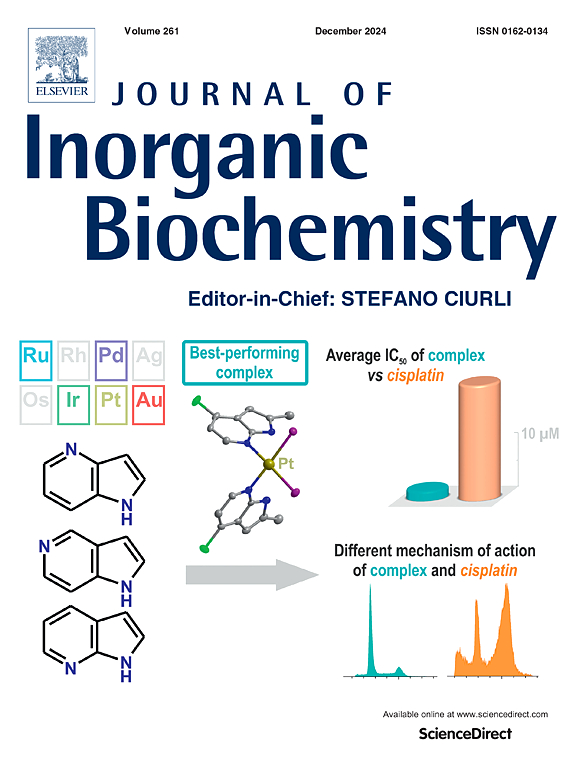Characterization of σ and π reaction channels in hydrogen atom transfer reactions
IF 3.2
2区 化学
Q2 BIOCHEMISTRY & MOLECULAR BIOLOGY
引用次数: 0
Abstract
C(sp3)–H bond activation mechanisms typically involve σ- and π-channel pathways, as characterized by FeOH (or FeOC) angles of ca. 180° and 120°, respectively. It is well known that the preference for either the σ- or π-channel depends on the spin state, but doubts exist on what would be characteristic values for the FeOX (X = H or C) angles. Here we study the oxidation of methane and ethane mediated by an Fe(IV)oxo model complex through density functional theory. A systematic comparison of dispersion-corrected B3LYP (B3LYP-D2, B3LYP-D3, B3LYP-D3BJ, B3LYP-D4) and the uncorrected counterpart (B3LYP) was conducted to evaluate the role of dispersion interactions in both gas and solvent phases. Our results reveal that dispersion corrections significantly influence barriers at transition states (TSs), particularly in the solvent phase, where dispersion contributions enhance stabilization of TS structures. The σ-channel pathway dominates for high spin (S = 2), while intermediate spin (S = 1) states favor the π-channel. Dispersion effects were found to be more pronounced for ethane, where larger non-covalent interactions between the substrate and Fe(IV)oxo complex arise. The FeOX angles vary substantially depending on the choice of dispersion correction, and between gas phase and solution phase. Indeed, for the reaction with ethane the FeOX values of the σ-channel approach values that are typically associated with the π-channel. Fortunately, the Spin-Resolved Charge Displacement Function provides a clear visual tool to distinguish the two channels. These insights advance the understanding of hydrocarbon functionalization by high-valent iron-oxo species, with implications for synthetic catalyst design in homogeneous and enzymatic catalysis.

氢原子转移反应中σ和π反应通道的表征
C(sp3) - h键的活化机制通常包括σ-通道和π-通道,表征为FeOH(或FeOC)的角度分别约为180°和120°。众所周知,对σ-或π-通道的偏好取决于自旋态,但对于FeOX (X = H或C)角的特征值存在疑问。本文通过密度泛函理论研究了Fe(IV)氧模型配合物对甲烷和乙烷的氧化作用。系统比较了分散校正的B3LYP (B3LYP- d2、B3LYP- d3、B3LYP- d3bj、B3LYP- d4)和未校正的B3LYP (B3LYP),以评估分散相互作用在气相和溶剂相中的作用。我们的研究结果表明,色散修正显著影响过渡态(TSs)的势垒,特别是在溶剂相,其中色散贡献增强了TS结构的稳定性。高自旋态(S = 2)以σ通道为主,而中自旋态(S = 1)以π通道为主。分散效应对乙烷更为明显,底物与Fe(IV)氧配合物之间的非共价相互作用更大。FeOX角度的变化取决于色散校正的选择,以及气相和溶液相之间。事实上,对于与乙烷的反应,σ-通道的FeOX值通常与π-通道相关。幸运的是,自旋分辨电荷位移函数提供了一个清晰的视觉工具来区分这两个通道。这些见解促进了对高价氧化铁类化合物功能化的理解,对均相催化和酶催化的合成催化剂设计具有重要意义。
本文章由计算机程序翻译,如有差异,请以英文原文为准。
求助全文
约1分钟内获得全文
求助全文
来源期刊

Journal of Inorganic Biochemistry
生物-生化与分子生物学
CiteScore
7.00
自引率
10.30%
发文量
336
审稿时长
41 days
期刊介绍:
The Journal of Inorganic Biochemistry is an established international forum for research in all aspects of Biological Inorganic Chemistry. Original papers of a high scientific level are published in the form of Articles (full length papers), Short Communications, Focused Reviews and Bioinorganic Methods. Topics include: the chemistry, structure and function of metalloenzymes; the interaction of inorganic ions and molecules with proteins and nucleic acids; the synthesis and properties of coordination complexes of biological interest including both structural and functional model systems; the function of metal- containing systems in the regulation of gene expression; the role of metals in medicine; the application of spectroscopic methods to determine the structure of metallobiomolecules; the preparation and characterization of metal-based biomaterials; and related systems. The emphasis of the Journal is on the structure and mechanism of action of metallobiomolecules.
 求助内容:
求助内容: 应助结果提醒方式:
应助结果提醒方式:


